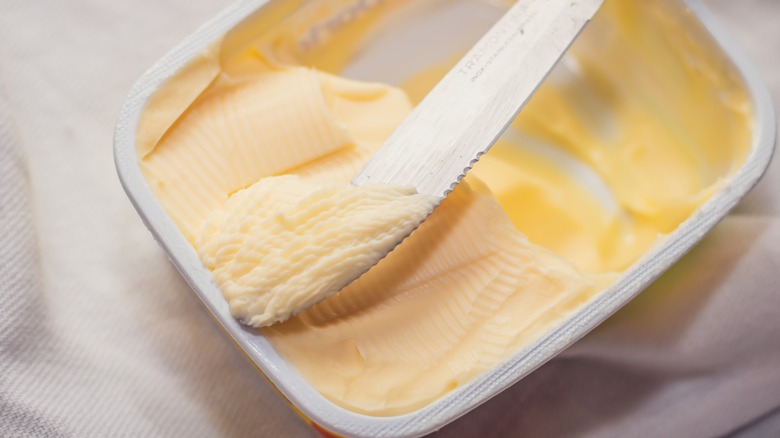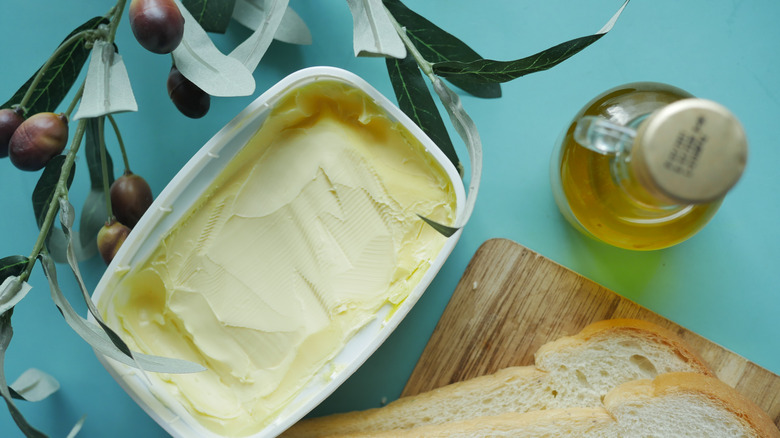Is There A Difference Between Plant-Based Butter And Margarine?
There's never been a better time to phase animal products out of your diet. Whether you're trying meatless Mondays or going all-in on veganism, you've got more options than ever to round out your meal prep. From plant-based meat substitutes to alternative kinds of milk to vegan egg replacements, all the protein bases are covered. Some products, like Impossible Burger, which uses a compound called heme that comes from soybeans to make plant-based meat that "bleeds," are pretty modern. Still, many products are just updated takes on grocery staples that have been around for a long time, like plant-based butter.
If you've browsed the dairy aisle lately, you've probably noticed a lot of vegetarian butter alternatives like Earth Balance, Melt, and Milkadamia. However, there's nothing new about plant-based butter. It's just an updated way to sell margarine, a product whose origins date back to 1813. Margarine has gone through multiple iterations and trends over the years, but the basic formula for making it comes down to a French scientist who discovered a fatty acid he named "margarites," also known as margaric acid, according to Mental Floss. The only real difference between today's plant-based butter spread and your grandma's stick of margarine is in the ingredients.
Read the label
In the late 1860s, during the time of Emperor Napoleon III, a French chemist named Hippolyte Mège-Mouriès won a competition organized by the European emperor to create an inexpensive butter substitute (per Mental Floss). That original margarine was made with churned beef tallow and milk, which is far from vegan-friendly. Since the 1950s, however, most margarine has been made without animal products, according to The Counter. There was far less demand for plant-based products back then, though. Instead, margarines were popular because they were cheaper than real butter, and in the 1980s and '90s, margarine was purported to be healthier. Newer products are made with trendier ingredients, like olive and avocado oil, flax, and cashews, but the process of making margarine is still the same. It's just marketed with different names like "spread" to avoid the stigma associated with trans fats.
Many of the products you see on the shelves at your local grocery store are probably safe to eat if you're vegetarian or vegan, but you should definitely do a double check, especially if you're lactose intolerant or have a dairy allergy because some margarines still contain trace amounts of animal products. Most plant-based butters are well-labeled and will say that they are vegan right on the packaging. If you're not sure, though, check the ingredients list for whey, lactose, casein, or caseinate, which are all animal-based. And, of course, avoid anything that says it's blended with real butter.
Health check
Health trends and margarine popularity tend to go hand in hand in the U.S. For example, margarine outsold butter by a huge margin in the 1970s because it is lower in saturated fat, and everyone thought it was healthier, according to the USDA. Older margarines were loaded with trans fats to make them solid, which can lower good LDL cholesterol and raise bad HDL (per Harvard Health). It took several decades to complete the research on trans fats, and by the time they were officially deemed no longer "Generally Recognized as Safe" in 2015 by the FDA, margarine was on the outs with American consumers.
Today's plant-based butters don't contain any trans fats by law, but they aren't necessarily any healthier than regular butter. Butter alternatives are usually lower in saturated fats than real butter, according to Harvard Health, but in the absence of trans fats, they are also often made with palm and coconut oils to make them solid, which still contain saturated fat. They're also high in calories and sodium just like butter, so you should eat them sparingly. The only real reason to choose plant-based butters and spreads is to avoid eating animal products for an allergy or ethics. Just be sure to read the ingredients list to make sure your sticks or spread are truly dairy free.


